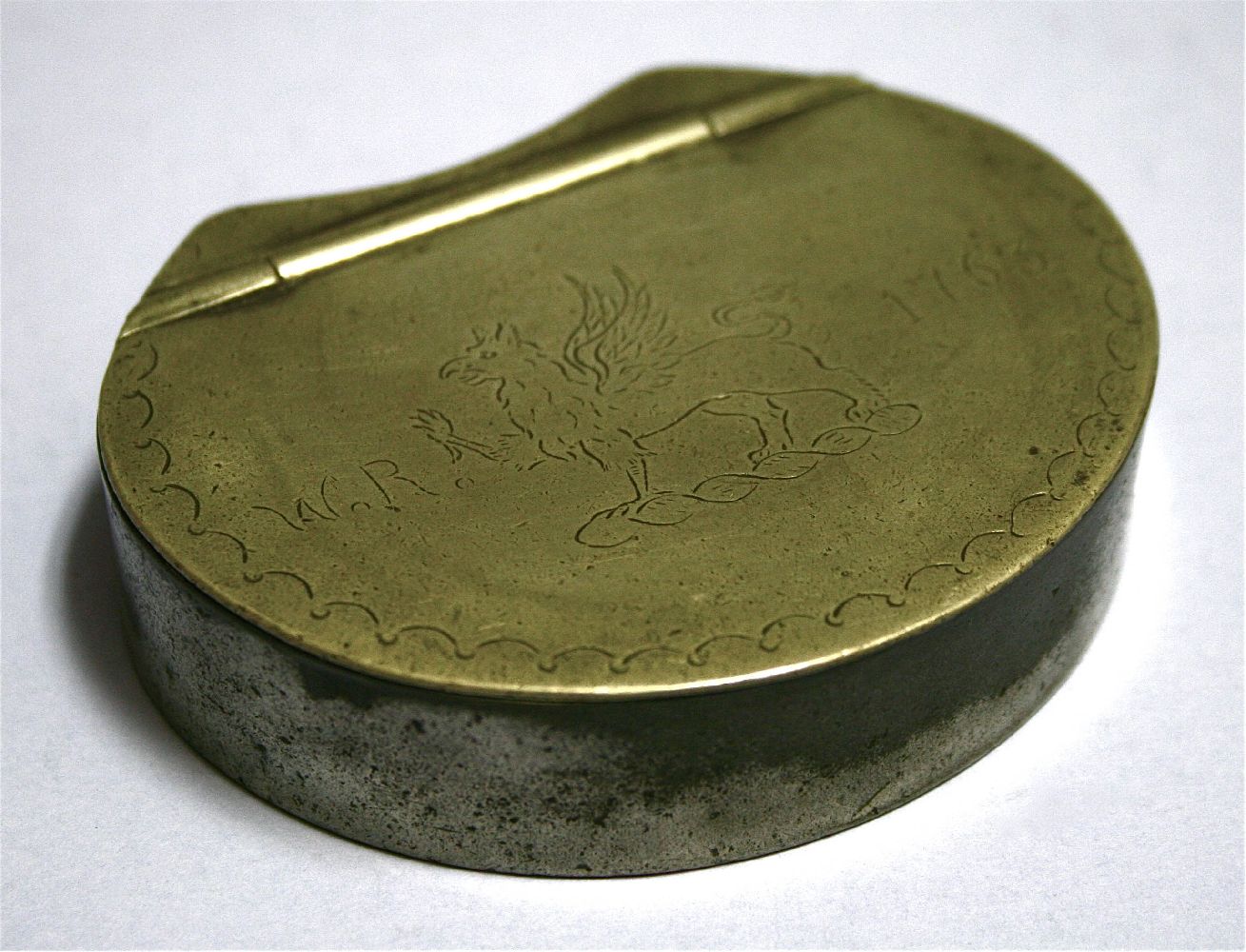

Title: Antique Handcrafted Pewter Designed Tobacco Snuff Box 1763
Shipping: $29.00
Artist: N/A
Period: Unassigned
History: N/A
Origin: Northern Europe > England
Condition: Museum Quality
Item Date: N/A
Item ID: 851
Hand made metal tobacco box, circa 1763 Lovely vintage art collectible mixed metal box: a decorative art piece. Crafted by a very skilled artisan. The metal is, most probably pewter. There is a logo and it is signed W.R. on the top of this beautiful designed and very old box. This is a very good, heavy, Mid 18th Century Antique Victorian Pewter Table Snuff or Tobacco Box. This box looks to come from Richard Ward (April 15, 1689 – August 21, 1763) was a governor of the Colony of Rhode Island and Providence Plantations. Tobacco is commercially available in dried, cured, and natural forms. In addition to being consumed as cigarettes and cigars, it can be smoked in a stem pipe, water pipe, or hookah. Tobacco can also be chewed, "dipped" (placed between the cheek and gum), or sniffed into the nose as finely powdered snuff. Many countries set a minimum smoking age, regulating the purchase and use of tobacco products. * We specialize in high end luxury fine art and collectibles from private estates. - Our job is to find and target great art by collecting a vast array of contemporary, vintage, antique and collectible items from across the globe. Individually handcrafted, we breathe new life into these forgotten relics by giving back each piece it's unique story. We welcome dealers, galleries, and private collectors to register securely and buy with us.
Link: http://en.wikipedia.org/wiki/Richard_Ward_%28governor%29
Richard Ward (April 15, 1689 – August 21, 1763) was a governor of the Colony of Rhode Island and Providence Plantations, serving for one complete term from 1741 to 1742. He was the son of Thomas Ward and Amey Billings of Newport, and grandson of John Ward who had come from Gloucester, England. His father was a merchant who held many positions in the town government, and his grandfather had been an officer in Cromwell's Army who came to the American colonies following the accession of King Charles II of England.
Ward was made a freeman of Newport in 1710, then entered public service as Attorney General, later became Deputy and Clerk of the Assembly, and then served as the General Recorder for the colony from 1714 to 1730. In 1723 he was paid six pounds for attending the trial of a group of pirates who were taken prisoner by Captain Solgar, commander of the British ship Greyhound. Of the 36 pirates taken into captivity, 26 were sentenced to hang, and the execution took place at Newport on July 19, 1723 at a place called Gravelly Point.
In 1726, Ward was one of the four Rhode Island commissioners appointed to meet a group of Connecticut commissioners to settle the boundary line between the two colonies. Ward was the Secretary of State from 1730 to 1733, and in 1740 became the Deputy Governor of the colony. In this capacity he and Samuel Perry were appointed trustees to the Inidan sachem Ninigret. In 1741 he was selected as Governor for a single term.
In 1709 Ward married Mary Tillinghast (1689 - 1767), the daughter of John and Elizabeth (Sayles) Tillinghast, and granddaughter of Pardon Tillinghast who had come from Seven Cliffs, Sussex, England. The couple had 14 children, the ninth of whom was Samuel Ward who would later become a governor of the colony and a delegate to the Continental Congress. Two other children, Thomas and Henry, both served lengthy terms as Secretary of the Colony. Richard Ward's older sister Mary married Sion Arnold, a grandson of Governor Benedict Arnold.
Ward is buried under a brick vault in the Common Burying Ground in Newport, and his son Samuel, after first being buried in Philadelphia, was re-interred next to him.
---> Year 1763 was a common year starting on Saturday.
•
• The family of Wolfgang Amadeus Mozart sets out on a European tour, visiting Paris and London.
• Edward Stone publishes his discovery of the medicinal properties of salicylic acid 1763.
• Publication of Nicolas Louis de Lacaille's Coelum australe stelliferum, cataloguing all his data from the southern hemisphere and including about 10,000 stars and a number of brighter star clusters and nebulae.
Thomas Bayes' solution to a problem of "inverse probability" is presented posthumously in his "Essay towards solving a Problem in the Doctrine of Chances" read by Richard Price to the Royal Society, containing a statement of a special case of Bayes' theorem 1763.
• Canaletto is elected to the Venetian Academy of Fine Arts.
• Francesco Zuccarelli (1702-1788) is elected to the Venetian Academy.